I have this scheme
I have to write structural VHDL design for it.
So these are my components: MUX:
library IEEE;
use IEEE.STD_LOGIC_1164.all;
entity mux is
port(
A : in STD_LOGIC_VECTOR(7 downto 0);
B : in STD_LOGIC_VECTOR(7 downto 0);
Sel : in bit;
Z : out STD_LOGIC_VECTOR(7 downto 0)
);
end mux;
architecture Beh of mux is
begin
Z <= A when Sel='1'else
B;
end Beh;
REG:
library IEEE;
use IEEE.STD_LOGIC_1164.all;
entity reg is
port(
C : STD_LOGIC;
LD : in bit;
Reg_in : in STD_LOGIC_VECTOR(7 downto 0);
R_out : out STD_LOGIC_VECTOR(7 downto 0)
);
end reg;
architecture Beh of reg is
begin
process (C)
begin
if (rising_edge (C)) then
if (LD = '1') then
R_out <= Reg_in;
end if;
end if;
end process;
end Beh;
TOP:
library IEEE;
use IEEE.STD_LOGIC_1164.all;
entity top is
port(
LDA, LDB, S1, S0 : in bit;
CLK : in STD_LOGIC;
X, Y : in STD_LOGIC_VECTOR(7 downto 0);
RB : out STD_LOGIC_VECTOR(7 downto 0)
);
end top;
architecture Beh of top is
signal regB_out : STD_LOGIC_VECTOR(7 downto 0);
signal regA_out : STD_LOGIC_VECTOR(7 downto 0);
signal mux1_res : STD_LOGIC_VECTOR(7 downto 0);
signal mux2_res : STD_LOGIC_VECTOR(7 downto 0);
begin
Mux1: entity mux(Beh)
port map
(
A => X,
B => regB_out,
Sel => S1,
Z => mux1_res
);
RegA: entity reg(Beh)
port map
(
LD => LDA,
C => CLK,
Reg_in => mux1_res,
R_out => regA_out
);
Mux2: entity mux(Beh)
port map
(
A => regA_out,
B => Y,
Sel => S0,
Z => mux2_res
);
RB<=regB_out;
RegB: entity reg(Beh)
port map
(
LD => LDB,
C => CLK,
Reg_in => mux2_res,
R_out => regB_out
);
end Beh;
I am not sure I wrote bind between RB, regB_out and B correctly. And in the waveform when S1 and S0 both equal 0, I get nonsence for 1 CLK period. Like on the screenshot at 600ns '01' on RB shouldn't be there. Can some one help me to find mistakes?
TestBench:
library IEEE;
use IEEE.std_logic_1164.all;
use IEEE.std_logic_signed.all;
use IEEE.numeric_std.all;
ENTITY tbt is
END tbt;
ARCHITECTURE behavior OF tbt IS
COMPONENT TOP
PORT (
CLK : in STD_LOGIC;
LDA, LDB, S1, S0 : in bit;
X, Y : in STD_LOGIC_VECTOR(7 downto 0);
RB : out STD_LOGIC_VECTOR(7 downto 0)
);
END COMPONENT;
signal CLK_sig : std_logic;
signal LDA_sig, LDB_sig, S1_sig, S0_sig : bit :='0';
signal X_sig, Y_sig, RB_sig : std_logic_vector(7 downto 0):="00000000";
constant CLK_period : time := 100 ns;
constant s_per : time := 50 ns;
begin
-------------------------------------------------------------
uut: TOP PORT MAP (
CLK => CLK_sig,
LDA => LDA_sig,
LDB => LDB_sig,
S1 => S1_sig,
S0 => S0_sig,
X => X_sig,
Y => Y_sig,
RB=> RB_sig
);
-------------------------------------------------------------
CLK_process :process
begin
CLK_sig <= '0';
wait for CLK_period/2;
CLK_sig <= '1';
wait for CLK_period/2;
end process;
-------------------------------------------------------------
stim_proc: process
variable itertion_backwards : integer := 255;
variable itertion_forward : integer := 0;
begin
wait for CLK_period;
for itertion_forward in 0 to 254 loop
X_sig <= STD_LOGIC_VECTOR(TO_SIGNED(INTEGER(itertion_forward),8));
Y_sig <= STD_LOGIC_VECTOR(TO_SIGNED(INTEGER(itertion_backwards),8));
wait for CLK_period;
S1_sig<= not S1_sig;
wait for CLK_period;
S0_sig<= not S0_sig;
wait for CLK_period;
LDA_sig<= not LDA_sig;
wait for CLK_period;
LDB_sig<= not LDB_sig;
itertion_backwards := itertion_backwards - 1;
end loop;
wait;
end process;
end;

